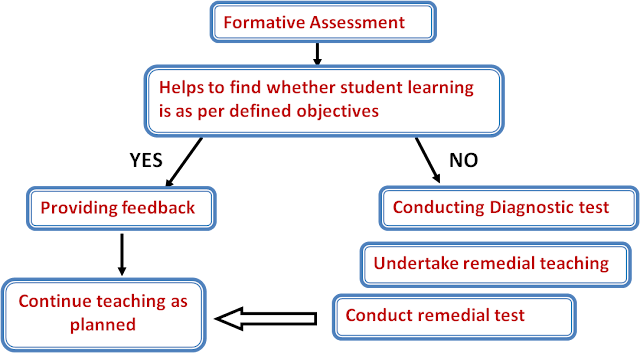Measuring students behavioural changes based on well defined educational objectives and interpreting the obtained scores meaningfully find an important place in educational assessment.
Such
assessments are of 2 types
- Formative Assessment
- Summative Assessment
Content
Important features of formative assessment
Examples of Formative Assessment
Diagrammatic Illustration of FA
Important features of summative
assessment
Examples of summative assessment
Diagrammatic illustration of SA
Difference between formative & summative
assessment
The
evaluative technique used to monitor learning progress during instruction and
to provide continuous feedback to both students and teacher concerning
learning, success and failures.
Important
features of formative assessment
- Formative assessments are interwoven with the ongoing teaching and learning process.
- It is used for monitoring students learning progress during the period of teaching.
- It tells how well students learn what are being taught, as the process of teaching is going on.
- A formative assessment is collaborative as it measures the student’s progress and the effectiveness of the teaching method.
- It provides continuous feedback to students and helps them to find their mistakes and shortcomings.
- It provides feedback to teachers so that they could make necessary changes in their teaching.
- The teacher can align his teaching to suit the immediate needs of the learners, adopting necessary changes in his instructional methods and techniques.
- It is a diagnostic method of evaluation.
- Results from formative assessments are immediately made available.
- Formative assessments are non-graded.
Examples
of Formative Assessment:
Few
examples of formative assessment includes
- Class discussions
- Checklists
- Quiz
- Questionnaires
- Peer/self evaluation
- Projects
- Assignments
- Multiple choice questions
- Observations
Benefits for Teachers
- To find how far the instructional objectives are achieved
- Helps to conduct diagnostic test and undertake remedial teaching for those who lack begin in learning
- Able to determine what standards students already know and to what degree.
- They can decide what minor modifications or major changes in instruction they need to make so that all students can succeed
- Can create appropriate lessons and activities for groups of learners or individual students.
- Teachers can inform students about their current progress in order to help them set goals for improvement.
- Helps in informing parents about their ward’s performance then & there.
Benefits For Students
- Students are more motivated to learn.
- Students take responsibility for their own learning.
- Students can become users of assessment alongside the teacher.
- Students learn valuable lifelong skills such as self-evaluation, self-assessment, and goal setting.
- Students become more adept at self-assessment
- Formative assessment reduces students test anxiety
Assessment
carried out at the end of any event, activity or process is known as summative
assessment.
Summative
evaluation is done at the conclusion of instruction and measures the extent to
which students have attained the desired outcomes
Important features of summative assessment
- Summative assessment attempts to find the proficiency achieved by the students against the instructional objectives established for course of study or educational program.
- It is generally carried out at the end of a particular instructional period (semester / one full academic year).
- In summative assessment, the learning proficiency achieved by the students in different parts and aspects of the syllabus for the course, is evaluated and represented by marks or grades.
- Summative assessment could be used to grade students on the basis of their level of learning achievement.
- It is also often used to decide who are all among the student eligible for promotion to the next higher class.
- Many kinds of test items, drawn from the different portions of the subject content, find place in summative test for examination.
- Test items in summative assessment vary in the difficulty level from easy to difficult and very difficult.
- Similarly, test items may evaluate students learning in the cognitive domain at the 3 levels. i.e, knowledge, understanding and application.
- Skill learning will be tested through practical examination.
Examples of summative
assessment
- State Assessments
- Standard based exams
- Unit/term test
- Project evaluation
- Practical examination
- Thesis Submission
- To identify the present level of educational proficiency of students.
- to classify students on the basis of their learning achievement.
- To take the decision whether or not to promote the student to the next higher class.
- To decide the further course of the educational journey of the students based on the marks or grades obtained.
- To find the overall performance of the teaching learning process
Difference
between formative & summative assessment
Conclusion
The principal difference between
these two assessment procedures is that, while the formative assessment is a
kind of the instructional process, summative assessment is a sort of grading
process. A balanced assessment is based on both the two, that provides
necessary information about the next steps of the teachers and to measure
student’s learning regarding the content standard.









2 Comments
Very clear explanation in YouTube and as well as in website.
ReplyDeleteThank you ma..😊
ReplyDelete